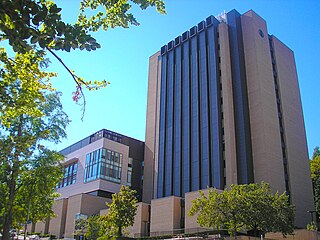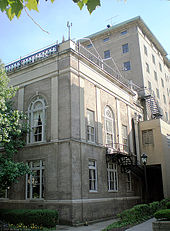
The Cathedral of Learning is a 42-story skyscraper that serves as the centerpiece of the University of Pittsburgh's (Pitt) main campus in the Oakland neighborhood of Pittsburgh, Pennsylvania, United States. Standing at 535 feet (163 m), the 42-story Late Gothic Revival Cathedral is the tallest educational building in the Western Hemisphere and the second-tallest university building in the world, after the main building of Moscow State University. It is also the second-tallest gothic-styled building in the world, after the Woolworth Building in Manhattan. The Cathedral of Learning was commissioned in 1921 and ground was broken in 1926 under general contractor Stone & Webster. The first class was held in the building in 1931 and its exterior finished in October 1934, prior to its formal dedication in June 1937. It is a Pittsburgh landmark listed in the National Register of Historic Places.

Fitzgerald Field House is a 4,122-seat multi-purpose athletic venue on the campus of the University of Pittsburgh in Pittsburgh, Pennsylvania, United States. Fitzgerald Field House is named for Rufus Fitzgerald, a past chancellor (1945–1955) of the university. It is the primary home competition venue for the university's gymnastics, volleyball, and wrestling teams.

University of Pittsburgh at Johnstown is a state-related college in Johnstown, Pennsylvania. It is a baccalaureate degree-granting regional campus of the University of Pittsburgh. The university is located in Richland Township, a suburban area of Johnstown, and was founded in 1927 as one of the first regional campuses of a major university in the United States.

The William Pitt Union, built in 1898 as the Hotel Schenley, is the student union building of the University of Pittsburgh main campus, and is a Pennsylvania and Pittsburgh History and Landmarks Foundation Historic Landmark. Designed by Pittsburgh-based architects Rutan & Russell in the Beaux-Arts style of architecture, the Schenley Hotel catered to local and visiting well-to-do people. The University of Pittsburgh acquired the property in 1956.

The University of Pittsburgh at Titusville is a state-related college in Titusville, Pennsylvania. It is a two-year campus of the University of Pittsburgh that provides associate degrees and pre-professional tracks with the potential to transfer students to other programs for baccalaureate degrees. In the fall of 2020, Pitt-Titusville converted its academic programs into the University of Pittsburgh at Titusville Education and Training Hub. This program incorporates three entities into UPT: Northern Pennsylvania Regional College (NPRC), the university's Swanson School of Engineering, and Manchester Bidwell Corporation.

Hillman Library is the largest library and the center of administration for the University Library System (ULS) of the University of Pittsburgh in Pittsburgh, Pennsylvania, United States. Located on the corner of Forbes Avenue and Schenley Drive, diagonally across from the Cathedral of Learning, Hillman serves as the flagship of the approximately 7.1 million-volume University Library System at Pitt.

Allen Hall at the University of Pittsburgh is a Pittsburgh History and Landmarks Foundation Historic Landmark and a contributing property to the Schenley Farms National Historic District. Completed in 1914 and originally serving as the home to the Mellon Institute of Industrial Research, the six story Greek Revival building designed by J. H. Giesey now serves as the home of the university's Department of Physics and Astronomy.

Chevron Science Center is a landmark academic building at 219 Parkman Avenue in Pittsburgh, Pennsylvania, United States on the campus of the University of Pittsburgh. The 15-story facility, completed in 1974, was designed by Kuhn, Newcomer & Valentour and houses the university's chemistry department. A three-story addition above Ashe Auditorium was completed in 2011.

Thaw Hall is a historic academic building on the campus of the University of Pittsburgh that is a contributing property to the Schenley Farms National Historic District and has been named a Pittsburgh History and Landmarks Foundation Historic Landmark. The five story building of stone, brick, and terra cotta was completed in 1910 in the Neoclassical Beaux-Arts style by architect Henry Hornbostel and today serves as space for a variety of academic classrooms, labs, offices, and centers. It is located between, and connected to, the university's Old Engineering Hall and Space Research Coordination Center (SRCC) along O'Hara Street in the Oakland neighborhood of Pittsburgh.

Bellefield Hall is a Pittsburgh History and Landmarks Foundation Historic Landmark and is a contributing property to the Schenley Farms Historic District on the campus of the University of Pittsburgh across Bellefield Avenue from Heinz Memorial Chapel and the lawn of the university's Cathedral of Learning in Pittsburgh, Pennsylvania, USA. A 1924 italianate structure by architect Benno Janssen, it originally served as a Young Men's and Women's Hebrew Association, but now houses rehearsal spaces, classrooms, offices, and a Digital Recording Studio for the University of Pittsburgh's Department of Music, as well as a university gymnasium, fitness center, indoor swimming pool, and a 676-seat auditorium.
The University of Pittsburgh's School of Computing and Information is one of the 17 schools and colleges of University of Pittsburgh located on the university's main campus in the Oakland section of Pittsburgh, Pennsylvania, United States. The school was formed in 2017 with a focus on academic programs that teach contextually situated computing in an interdisciplinary manner. The school offers bachelor's, master's, and doctoral degrees as well as certificate programs and houses three departments: Computer Science, Informatics and Networked Systems, and Information Culture and Data Stewardship.

Gardner Steel Conference Center (GSCC) is an academic building of the University of Pittsburgh and a contributing property to the Schenley Farms National Historic District and a Pittsburgh History and Landmarks Foundation Historic Landmark.

Schenley Quadrangle is a cluster of University of Pittsburgh ("Pitt") residence halls that is a Pittsburgh History and Landmarks Foundation Historic Landmark and are contributing properties to the Schenley Farms National Historic District in Pittsburgh, Pennsylvania, United States.

Michael L. Benedum Hall of Engineering is a landmark academic building on the campus of the University of Pittsburgh in Pittsburgh, Pennsylvania, United States. The building was designed in the brutalist style by the architectural firm of Deeter, Ritchey, and Sippel and completed in 1971 at a cost of $15 million. The building was honored with both the Pennsylvania Society American Institute of Architects Honor Award and Distinguished Building Award. It was built with a gift from the Claude Worthington Benedum Foundation and funds from the General State Authority. It stands on a 1.8-acre (7,300 m2) site that was formerly occupied by the National Guard's Logan Armory.

David Lawrence Hall is a major academic building at the University of Pittsburgh in Pittsburgh, Pennsylvania, United States, where it serves as the school's largest lecture hall and auditorium facility.

Parran Hall is the former name of an academic building on the campus of the University of Pittsburgh on Fifth Avenue in Pittsburgh, Pennsylvania, United States. The building, constructed to house the Graduate School of Public Health, was completed in 1957, and designed by Eggers & Higgins, architects of the Dirksen Senate Office Building, in the International Style with a major addition by Deeter-Ritchey-Sippel and Crump completed in 1967. The school was founded in 1948 with a $13.6 million grant from the A.W. Mellon Educational and Charitable Trust. It was originally named after Thomas Parran Jr., a former head of the United States Public Health Service at the time the Public Health Service was sponsoring the Tuskegee experiment, in which patients with syphilis were studied but did not receive treatment for the disease.

Ruskin Hall is a residence hall at the University of Pittsburgh and a contributing property to the Schenley Farms National Historic District. Constructed in 1921–22 by H. L. Stevens & Company, with an annex added in 1925–26, it is an eight-story building which is located between the Music Building and Information Sciences Building between Ruskin and Bellefield Avenues near Fifth Avenue on Pitt's main campus in the Oakland neighborhood of Pittsburgh, Pennsylvania. Ruskin Hall recently underwent a $19.4 million conversion and renovation from medical student housing into undergraduate apartment-style housing that opened in 2008.

Joseph C. Trees Hall is a multipurpose student, staff, faculty recreational facility on the campus of the University of Pittsburgh in the Oakland section of Pittsburgh, Pennsylvania. First opened in 1962 with a second phase of construction was completed in 1965, Trees Hall houses the School of Education's Department of Health and Physical Activity, various student recreation facilities, a pool that serves as the home to Pitt's varsity men's and women's swimming and diving teams, and the primary training facility for Pitt's varsity women's gymnastics team.

The University Child Development Center (UCDC) at the University of Pittsburgh is a child care and early childhood education center located on Clyde Street in Shadyside just east of the main Oakland campus approximately one half mile from the center of campus at the Cathedral of Learning and adjacent to the rear property of the University's Chancellor's Residence on the Oakland-Shadyside border in Pittsburgh, Pennsylvania.

The O'Hara Student Center, formerly the Concordia Club, is a three-story, 18,000-square-foot (1,700 m2) building on the campus of the University of Pittsburgh on O'Hara Street in the Oakland neighborhood of Pittsburgh, Pennsylvania. It is a contributing property to the Schenley Farms National Historic District and the City of Pittsburgh Oakland Civic Center Historic District. The building was acquired by the university in mid-December, 2009. and has since been renovated to house academic and student activity programs.

























